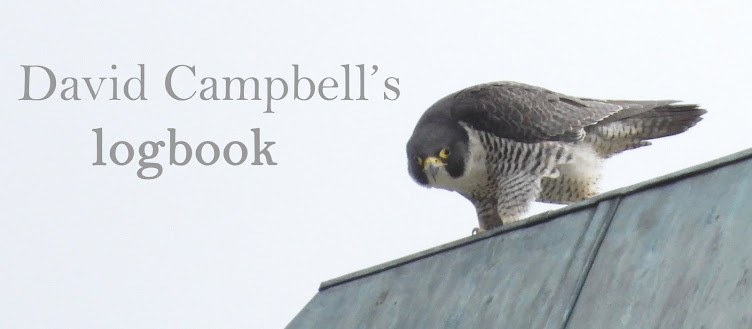I've been away for the last few days. First of all I was in Norfolk, on Saturday and Sunday. I didn't really have time to do much birding as such but helped
David Darrell-Lambert with a survey, where we found five
Stone-curlews, a juvenile female
Goshawk and a fair few
Crossbills. There with family to see my unce and aunt, we spent Sunday afternoon on their boat on Hickling Broad - picked up a few marshland birds there including a couple of
Marsh Harriers and a few
Common Terns.
 |
| Stone-curlew, just into Suffolk |
Early on Monday morning I set off for Cornwall where a couple of days of seawatching were planned with Liam. Arriving at Porthgwarra mid-morning we set up our scopes and began our vigil. It was obvious that things weren't going to kick off and we only managed to pull a couple of
Balearics out of the bag. I took this opportunity to catch up on a little sleep and kipped for a while as Liam kept watch. A
Chough was a welcome bit of extra interest. Also three
Ravens. We checked the Hayle Estuary where there was a selection of common waders including a couple of
Whimbrel, decent numbers of
Sanderlings and an impressive gathering of 18
Common Sandpipers. Also a couple of
Med Gulls.
Tuesday morning the conditions didn't look terribily great but we thought we'd give it a good go and set the alarm for 5.30am. There was slightly more variety with a
Storm-petrel and a couple of
Puffins alongside
Balearic Shearwater, but we only recorded one of this species! I was starting to think this seawatching trip was going to be a disaster when Liam shouted that he had a large shearwater, praying it to be my main quarry I managed to get onto it fairly quickly and indeed it was a
Cory's Shearwater! It was quite far, being noticably beyond the Runnelstone but it was enough to see what it was and we had it in view for about five minutes as it headed east; the bird's primaries on one wing were pretty bashed up. Mission accomplished then, Cory's being one of my biggest remaining 'tart's ticks', we packed it in late morning and headed to the Hayle Estuary where we found much of the same as the previous day. That was enough birding for the day for us and we chilled at Liam's flat for the rest of the day, in keen anticipation of what was perhaps to come in the morning, when the weather looked favourable for seabirds.
The alarm was set early once more yesterday morning and as soon as we stepped out of the flat we could tell that we were probably in for a decent watch. We started seawatching from the cove near the car park and Liam, being on fire with large shearwaters, picked up a
Great Shearwater heading west - superb! A few minutes later and I located two birds headed past together... things were looking good. About an hour in and we were also into double figures of
Balearic Shearwaters and had clocked a couple of
Storm-petrels as well as a
Bonxie. We moved up to Hella Point where a couple of birders we'd met on Monday had just arrived. It wasn't long before we started picking up the odd
Great Shearwater again and the tally steadily increased. Eventually, one bird proved to be a
Cory's Shearwater; it was surprising that the ratio of big shears favoured Greats to such an extent. After the other birders left we had another
Bonxie, another
Cory's and additional
Great Shearwaters. The resident pair of
Choughs showed well, doing their undulating flight right by us. Martin Elliott and a friend then arrived and after a lull the action resumed, with further
Great Shears and another
Cory's, this time giving the views that I was after as it lazily toured the waves within Runnelstone distance. This saw me satisfied, I needed to get back home at a reasonable time and Liam wanted to get back to see his friends at his flat to we called it a day shortly before 4.00pm, following a long and productive seawatching shift, perhaps the best seawatch I've ever had. We said goodbye to the other chaps and Liam told them they were bound to get something like a Fea's Petrel now that we were leaving... later that evening I heard less than two hours after we left they picked up nothing other than a bleeding Fea's Petrel... bloody gutting to come that close and I didn't realistically see that coming at the time (though I might have been keen to stay a little longer if I'd known about the three Fea's Petrels in Ireland before we left). That's birding, the high of seeing scarce birds followed by the sinking feeling when you realise what you'd have been treated to if you'd stayed just a little longer......
We finished our birding off with a call in at Hayle on the way back to Liam's flat. Quiet, but six
Med Gulls were nice to see. Cheers Liam for the hospitality - most kind!



























